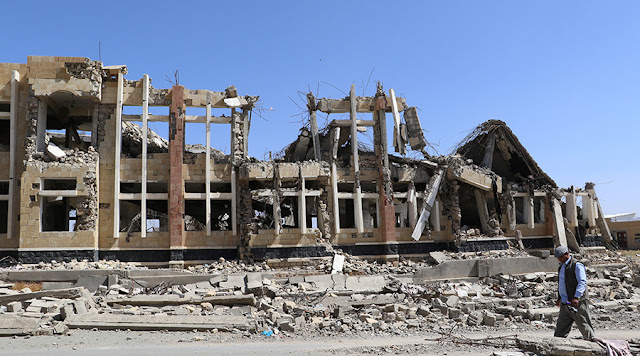A woman holds her son who is suspected of being infected with cholera in Sanaa. © Khaled Abdullah / Reuters
Yes, there is a woman in this photo - she's invisible, as are all women in devout Islam
Yemen’s cholera outbreak has surpassed the 1 million mark while 300 cases of diphtheria have been reported as civilians in the war-ravaged country continue to face starvation and a crippling blockade. “We can confirm that the country has now reached 1 million suspected cases of cholera,” the International Committee of the Red Cross said. “This is devastating.”
The World Health Organization has recorded 2,226 deaths since the epidemic began in April. Cholera causes severe diarrhea and dehydration and is spread by dirty water and the contamination of food with feces. It can cause death within hours if untreated.
The ICRC also said over 80 percent of Yemen is in need of food, clean water, healthcare and fuel.
The country is in the grips of a brutal war, with a Saudi-led coalition of nine countries conducting airstrikes against the Houthi rebels in support of President Abdrabbuh Mansour Hadi, who fled the country in 2015.
The Houthis were in alliance with long-running former President Ali Abdullah Saleh, who they killed in December after indicating he was changing sides and seeking dialogue with the Saudis.
The Houthi rebels are supported by Iran, which is also accused of supplying weapons to the group, a charge which Iranian Foreign Minister Mohammad Javad Zarif described as “baseless accusations,” on Wednesday.
Saudi Arabia has imposed a blockade on the country, which has further intensified the food and aid shortage. On Wednesday, it said it would keep the rebel-controlled port of Hodeidah open for 30 days to allow humanitarian deliveries to get into the country.
In January, the UN Office for the Coordination of Humanitarian Affairs said the civilian death toll had reached 10,000, citing data gathered by health facilities, and said the actual number could be much higher.
The United Nations on Tuesday said coalition airstrikes had killed at least 136 civilians between December 6 and 16.
“We urge all parties to the conflict to respect their obligations under international humanitarian law, including their obligation to respect the principles of distinction, proportionality and precaution,” Rupert Colville, spokesperson for the Office of the UN High Commissioner for Human Rights (OHCHR) said.“They should take all feasible precautions to avoid, and in any event to minimise, the impact of violence on civilians.”
Meanwhile, MSF announced in Geneva on Thursday the country also faces a diphtheria outbreak, with more than 300 cases reported. “In Yemen, the last diphtheria case was recorded in 1992, and the last outbreak in 1982,” MSF Emergency Coordinator said. “The ongoing war and blockade is sending Yemen’s health system decades back in time.”
At about the same time as the above report came out,
the Pentagon confirms ‘multiple ground ops & 120+ strikes’ in Yemen
Why is the US in Yemen?
A man walks past a graffiti, denouncing strikes by U.S. drones in Yemen, painted on a wall in Sanaa, Yemen
on November 13, 2014. © Khaled Abdullah / Reuters
The Pentagon has disclosed that it carried out “multiple ground operations” in Yemen this year. The confirmation sheds new light on largely covert US military activities in the region.
US forces have conducted “multiple ground operations and more than 120 strikes in 2017,” according to a statement released by US Central Command in Tampa, Florida. The US military hopes to prevent Al-Qaeda in the Arabian Peninsula (AQAP) and Islamic State from using Yemen “as a hub for terrorist recruiting, training and base of operations to export terror worldwide,” the statement reads.
The 120 claimed strikes against targets in Yemen would mark a 3-fold increase compared to the number of airstrikes from last year.
Before Wednesday’s statement, there had been few official disclosures of the extent of US military involvement in Yemen. In sharp contrast to the fight against IS in Syria and Iraq, the Pentagon has avoided holding regular briefings or updates on ground or air operations in Yemen.
However, there are sporadic reports of US military activity in the country. US Central Command said earlier this month that five Al-Qaeda militants had been killed in a US airstrike that took place on November 20 in Yemen’s Bayda Governorate.
The Pentagon previously acknowledged that the US “has people on the ground” in Yemen. According to media reports, in April, US special operations forces stepped up ground operations in Yemen, but military officials did not elaborate on the matter. It is still unclear exactly how many US boots are on the ground in Yemen. A White House report submitted to Congress last week detailing US military operations worldwide failed to disclose the number of US troops stationed in Yemen.
In February, it was revealed that a botched US raid in the country had left at least 25 civilians and one Navy SEAL dead. Inquiries into the disaster found that the raid yielded no significant intelligence, but the Trump administration nonetheless praised the mission as a success. Apart from the deaths, a $70 million military helicopter was also destroyed.
The latest acknowledgement of US ground operations in Yemen raises questions about the legality of such activity with respect to Yemen’s sovereignty.
Kim Sharif, director of Human Rights for Yemen, said in March, “the Yemeni people are saying: ‘Where are the other powers in the Security Council? Why aren’t they standing up for the sovereignty of Yemen, when clearly it is in their best interest as well to do so, because they surely must have business interest, commercial interest to protect and preserve the sovereignty of Yemen for the purpose of preserving that international passage for the benefit of all.’”






No comments:
Post a Comment